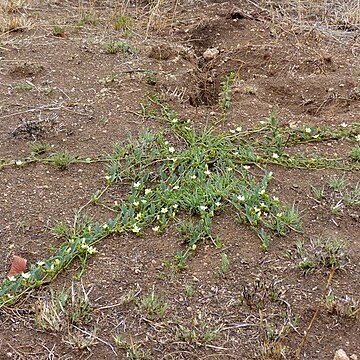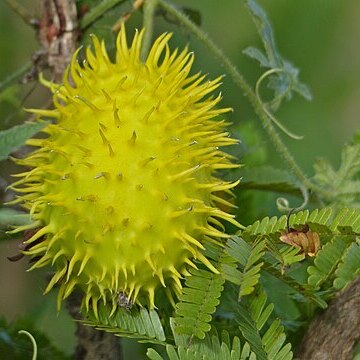Monoecious, perennial herb, roughly hairy to scabrid, rootstock woody. Stems prostrate, up to 2 m long. Leaves up to 65 x 55 mm, outline ovate, base cordate, apex acute, 5-palmately lobed; margins serrate, central lobe largest, pinnatifid; petioles 15-40 mm long. Tendrils simple. Male flowers mostly solitary; pedicel up to 28 mm long; receptacle campanulate, 3-5 mm long; lobes oblong, up to 4 mm long; corolla funnel-shaped, ± hairy inside and outside; tube up to 1 mm long; lobes elliptic or obovate, up to 7 mm long. Female flowers solitary; pedicel up to 15 mm long; receptacle ellipsoid, up to 13 mm long, aculeate outside, ± hairy inside; lobes ± linear, up to 3.5 mm long; corolla ± hairy inside and outside; tube up to 2 mm long; lobes up to 5 mm long. Flowering time Nov.-Apr. Fruit ellipsoid, 40-50 mm long, light and dark green lengthwise stripes, ripening mono-coloured yellow; toxic; pedicel up to 40 mm long. Seeds elliptic, up to 6.5 mm long.
A herb. It is a pumpkin family plant. It keeps growing from year to year. It has a woody rootstock. Kinds with non bitter fruit have to be chosen. The leaves are 3-9 cm long by 2-6 cm wide. The leaves usually have 3-5 deep lobes. These are triangle shaped. Male and female flowers are separate on the same plant. Male flowers occur singly and also the female flowers. The flowers are yellow. The fruit are 3-5 cm long by 2-4 cm wide. They are oblong and softly spiny. The seeds are 5-8 mm long and about 2 mm wide. They are whitish. Plants can be diploid or tetraploid.
Leaf-lamina 2·5–9 × 2–6 cm., ovate or rarely ovate-triangular, weakly cordate, hispid-setulose above and especially on veins beneath, becoming scabrid-punctate above and more densely so beneath, sinuate-serrate or denticulate, rarely unlobed, usually deeply palmately 3–5-lobed, lobes triangular, ovate-triangular or usually elliptic or narrowly elliptic, the central usually much the largest, 3–5-lobulate or lobulate-denticulate, acute to obtuse, apiculate.
Perennial herb. Stems procumbent or scandent. Tendrils simple. Stems and petioles retrorsely scabrid-setose. Leaves with blade ovate or elliptic to oblong, 25-100 x 20-70 mm, deeply palmately 3-5-lobed. Flowers: corolla up to 9 mm long; yellow; Oct.-May. Fruit uniformly yellow when ripe, softly spiny, spines rather slender, 2-16 mm long; fruit stalk 19-51 mm long, not expanded upwards.
Prostrate or scandent perennial herb. Tendrils solitary at each node. Stems and petioles retrorsely scabrid-se-tose. Corolla lobes up to 9 mm long. Fruit uniformly yellow when ripe, softly spiny, spines rather slender, 2-16 mm long; fruit stalk 19-51 mm long, not expanded upwards. Flowers yellow.
Fruit 3·4–5·2 × 2·3–3·5 cm., oblong, ellipsoid or obovoid-ellipsoid, softly spiny, concolorous green or striped dark and light green or green and yellow, concolorous yellow when ripe; spines rather slender, 2–16 mm. long; fruit-stalk 1·9–5·1 cm. long.
Female flowers solitary; pedicel 14–25 mm. long; ovary 8–11 × 4·5–6 mm., ellipsoid, densely softly setulose; perianth similar to that of male flowers.
male flowers solitary; pedicel 3–12(22) mm. long. Receptacle-tube 2·5–4·5 mm. long, lobes 1–4 mm. long. Petals 4·5–9 mm. long, yellow.
Perennial with fibrous woody tuberous rootstock; stems prostrate or rarely scandent, strongly recurved-setulose or aculeate.
Petiole 0·5–4 cm. long, strongly and densely recurved-setulose, very scabrid.
Seeds 5·2–8·4 × 2·2–4·5 × 1·5–2·0 mm., elliptic in outline, whitish.
Flowers monoecious.


